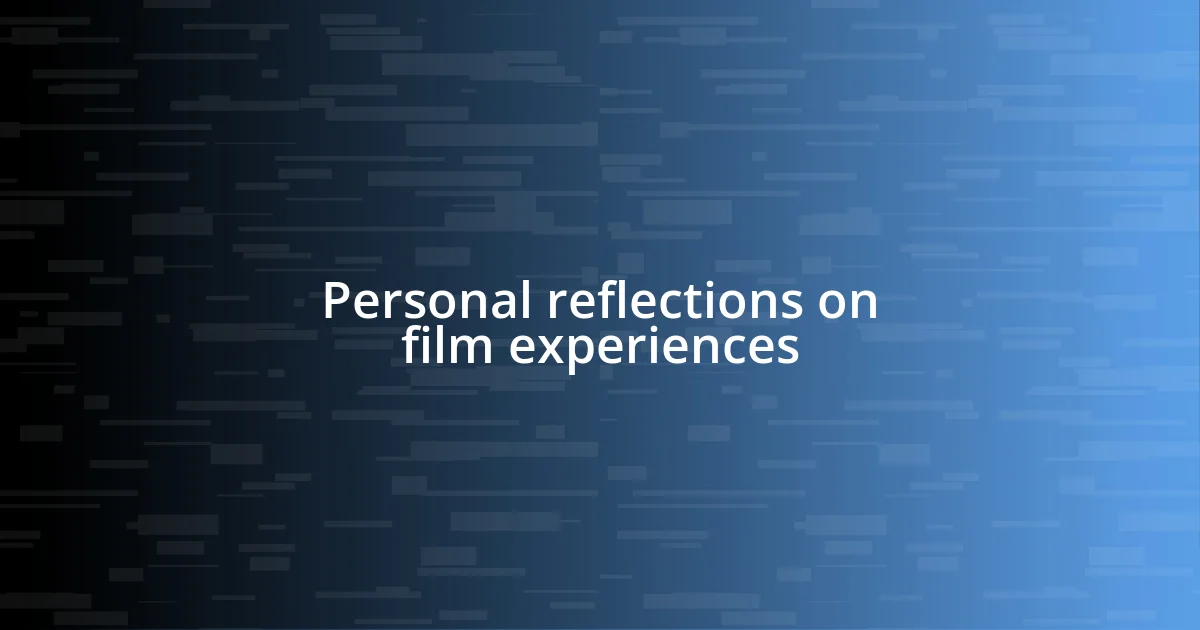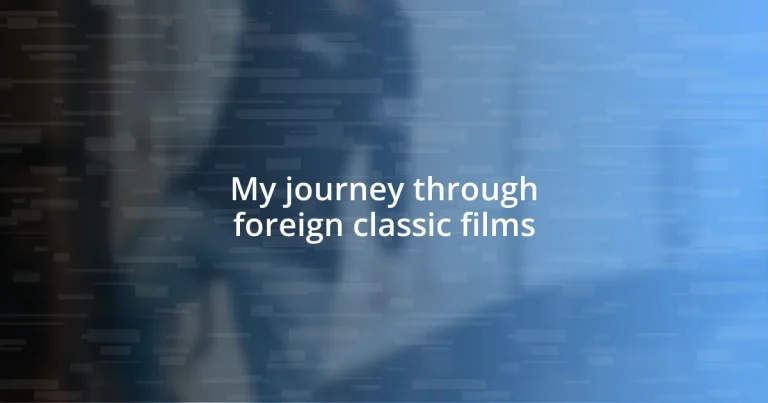Key takeaways:
- The exploration of foreign classic films reveals cultural nuances and universal human themes such as identity, love, and existentialism.
- Iconic directors like Ingmar Bergman, Federico Fellini, and Akira Kurosawa employ unique storytelling techniques that evoke deep emotional responses and provoke thought about reality and perception.
- Experiencing foreign films can create profound personal connections and reflections, allowing viewers to relate to themes of nostalgia, societal issues, and shared humanity across cultures.

Understanding foreign classic films
When delving into foreign classic films, I often find myself captivated by the cultural nuances that shape each narrative. For instance, watching Akira Kurosawa’s “Seven Samurai” was an enlightening experience; it opened my eyes to the profound themes of honor and sacrifice within Japanese culture. Have you ever noticed how a film can transport you to another world, making you feel the weight of a different history?
Understanding these films requires more than just watching; it involves an appreciation of the context in which they were made. I remember feeling overwhelmed watching Federico Fellini’s “8½” for the first time— it was a surreal exploration of creativity and the chaos of filmmaking. Did you ever feel lost in a film but then realized that discomfort was part of experiencing something extraordinary?
There’s an undeniable emotional layer in foreign classics that resonates on a universal level. I still recall how deeply moved I was by the poignant melancholy in Ingmar Bergman’s “The Seventh Seal,” as it explored existential themes that felt familiar despite the cultural distance. Isn’t it fascinating how these timeless stories remind us of our shared humanity across borders?

Key themes in foreign cinema
Key themes in foreign cinema often reflect the unique societal issues and emotional landscapes of the cultures they represent. From my experience, these films frequently tackle complex notions such as identity, love, and the human condition itself. It’s intriguing how viewing a film like “La Haine” sparked my reflections on social class and racial tension in France— themes that echoed my own observations of societal disparities closer to home.
Here are some prevalent themes I’ve noticed across various foreign films:
-
Identity and Belonging: Many films explore characters’ struggles with their cultural identity, often resonating deeply with viewers who grapple with similar issues.
-
Love and Sacrifice: Relationships are portrayed in multifaceted ways; whether it’s familial love or romantic passion, they often highlight the sacrifices people make.
-
Social Inequality: A significant number of films critique societal structures, showcasing the struggles of the marginalized—something that I think becomes even more poignant in our globally connected world.
-
Existentialism: I find this theme particularly powerful; the questioning of life’s meaning and purpose connects with audiences on an inherently human level, as seen in works like “The Seventh Seal.”
-
Memory and Trauma: Films often reflect on historical tragedies, serving as a reminder of the lasting impact of our past on present lives. Witnessing this in “Amour” left me contemplating the fragility of life and love.
When I immerse myself in a film that deftly weaves these themes, it feels as though I’m not just watching a story unfold—I’m engaging in a dialogue with the culture and its people, allowing their experiences to enhance my understanding of the world.

Iconic directors and their styles
Understanding the distinctive styles of iconic directors is like stepping into their unique worlds, where every frame tells a story. For me, watching Ingmar Bergman is an immersion into the complexities of the human psyche. His use of stark contrasts and close-up shots creates an intimacy that pulls me closer to the characters’ experiences. Have you ever felt that magnetic pull while watching a film?
Federico Fellini, on the other hand, crafts his narratives with a dreamlike quality that often feels both whimsical and profound. I remember being enchanted by his film “La Dolce Vita,” where the juxtaposition of joy and despair in the glamorous life of the protagonist resonated deeply with my own observations of societal façade. Each whimsical scene felt like an invitation into a carnival of life, leading me to question the nature of happiness itself. Isn’t it interesting how different styles can evoke such varied emotions?
In contrast, Akira Kurosawa’s storytelling blends epic scale with profound moral dilemmas. Watching “Rashomon” for the first time was a revelation; the fragmented narrative challenged my perceptions of truth and perspective in filmmaking. His attention to detail and ability to convey complex emotions through simple visuals has left a lasting impression on my understanding of cinematography. I often ponder whether we can ever fully grasp the truth of a moment, or if life itself is just a series of perspectives colliding together.
| Director | Style |
|---|---|
| Ingmar Bergman | Intimate close-ups and existential themes |
| Federico Fellini | Whimsical, dreamlike storytelling |
| Akira Kurosawa | Epic narratives with moral complexities |

Must-watch foreign classic films
When it comes to must-watch foreign classic films, there’s a title that always leaps to my mind: “Bicycle Thieves.” This Italian neorealism masterpiece captures the post-war struggle of a father searching for his stolen bicycle, which is crucial for his job. The film’s raw portrayal of desperation and hope struck a chord with me. Have you ever felt the weight of responsibility like that? It’s an emotional rollercoaster that lingers long after the credits roll.
I can’t talk about foreign classics without mentioning “The 400 Blows.” François Truffaut’s semi-autobiographical tale of a young boy’s rebellion against the constraints of the world around him resonates so deeply, especially in my teenage years. Watching Antoine Doinel’s struggles made me reflect on my own feelings of alienation. It’s fascinating how a film can open the door to our internal worlds, don’t you think?
Then there’s “Rashomon,” which I find both fascinating and unsettling. The layers of conflicting narratives left me questioning the very nature of truth. I remember having a deep discussion with friends after we watched it, trying to unpack our own biases and perceptions. Films like this don’t just entertain; they provoke thought and conversation about our realities, pushing us to look beyond our own experiences. Isn’t that what art is all about?

Cultural impacts of foreign films
Watching foreign films has opened a window to different cultures, and it’s fascinating how they can impact our understanding of the world. For instance, when I watched Pedro Almodóvar’s films, I was introduced to the complexities of Spanish life, full of vibrant colors and intense emotions. Those films really made me appreciate cultural nuances, like how family dynamics can be both supportive and suffocating. Have you ever noticed how films can mirror and magnify the cultural contexts they come from?
Moreover, foreign films often challenge our preconceived notions by showcasing social issues that may not be prevalent in mainstream cinema. I recall watching the French film “La Haine,” which gave me profound insights into the struggles of marginalized communities. The raw depiction of disillusionment among the youth made me reflect on social justice issues in my own community. Isn’t it striking how a story set miles away can initiate a conversation about our own society?
Lastly, the artistic techniques employed in these films, such as unique storytelling methods or unconventional narratives, can inspire filmmakers around the globe. I’ve been particularly moved by the use of silence in films like “The Spirit of the Beehive,” a Spanish classic that speaks volumes without words. This approach made me realize that sometimes what isn’t said is just as powerful as dialogue. Have you ever had that moment where a single visual captures your attention and emotions far more than any words could? It’s a reminder of the universal language of cinema that transcends geographical boundaries.

Analyzing film techniques and storytelling
Analyzing the film techniques used in foreign classics often reveals a distinct approach to storytelling. Take, for instance, the use of long takes in “The Bicycle Thieves.” I remember being mesmerized by how the camera seemed to linger on moments, allowing tension and emotion to build organically. It’s extraordinary how such technique can transport viewers into the characters’ world, making their struggles feel more acute. Have you ever found yourself holding your breath during a particularly intense scene, waiting for the resolution?
The use of symbolism frequently enhances the depth of narratives in foreign films. Consider the haunting imagery in “Rashomon” as it layers each perspective with visual metaphors. In my viewing experience, this multi-faceted storytelling forced me to confront the complexities of memory and truth. It’s as if each character’s truth mirrored my own experiences of how we often filter our memories through personal biases. Isn’t it fascinating how a single film can provoke such deep questions about our perceptions?
Moreover, the sound design in many foreign films very often plays a crucial role in storytelling. I can vividly recall the chilling silence in “The Spirit of the Beehive,” which drew me into the psychological landscape of the characters. The absence of noise made me reflect on the profound impact of what we don’t hear—a powerful reminder that silence can speak volumes. Have you encountered films where the soundscape resonated with your emotions more than dialogue? It’s incredible how these techniques work together to create a rich tapestry of storytelling that stays with you long after the film ends.

Personal reflections on film experiences
Reflecting on my film experiences, I often find that the emotional journeys depicted in foreign classics resonate deeply with me. For example, the first time I watched “A Man and a Woman,” I was captivated by the palpable longing between the characters. Their silent exchanges spoke volumes about love and the unspoken burdens we all carry. Have you ever felt that a film captures a moment in your own life so perfectly that it almost feels surreal?
I can still remember the rush of emotions after viewing “Cinema Paradiso.” The bittersweet nostalgia intertwined with my memories of childhood made me both grateful and a little melancholic. It’s interesting how films can evoke such strong emotions, connecting us to our experiences in a way we might not have anticipated. Isn’t it remarkable how storytelling can bridge the gap between our past and the communal experience of watching a film?
Sometimes, I find myself reflecting on the unexpected connections I make with characters across cultures. In “Walkabout,” I was particularly struck by the theme of survival and the innocence of youth, which transcended its Australian setting. I couldn’t help but recall my own childhood adventures and the simplicity of my worries back then. It leaves me pondering: how often do we overlook these universal truths in our own lives while getting lost in daily complexities? Those moments of recognition remind me that, at the heart of every story, we share a common humanity.














